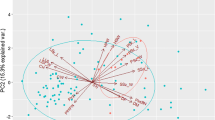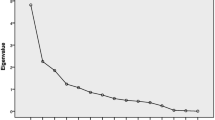Abstract
A total of 286 genotypes were collected from 39 countries of the world and were evaluated to determine the phenotypic diversity for 17 quantitative traits. Higher degree of coefficient of variation were recorded for grain yield−5 (52.46%), biomass−5 (45.73%), fresh pod width-10 (47.24%), dry pod weight−10 (40.33%), plant height−1 (35.25%), harvest index (32.70%) and number of branches−5. Cluster-II clearly reflected that late genotypes were having lightest pods weight, shortest pod width, and pod length; low grain yield, biomass and harvest index. Width, and pod length; low grain yield, biomass and harvest index. While genotypes in Cluster-III were in contrast to Cluster-II having heaviest pods weight, longest pods width and length, highest grain yield, biomass and harvest index. Higher PC−1 values have been determined for days to flower initiation which consequently were contributing weighed positive to days to pods picking, days to flower completion, days to dry pod appearance, days to plant harvesting while negatively contributed to yield producing traits, indicating that late flowering pea germplasm emphasizes more on the vegetative growth and was low yielding. However, higher PC−2 values have been obtained for number of branches−5, grain yield and biomass while lower values for days to flowering, days to pods picking, days to flower completion, days to dry pod appearance and days to plant harvesting confirming the fact that early genotypes were high yielding.
Similar content being viewed by others
References
Husle, J.H., Nature, Composition and Utilization of Food Legumes, Expending the Production and Use of Cool Season Food Legumes, Muehlbauer, F.J. and Kaiser, W.J., Eds., Dordrecht: Kluwer, 1994, pp. 77–79.
Nazir, S., Bashir, E., and Bantel, R., Crop Production, Islamabad: National Book Foundation, 1994.
Anonymous, Agricultural Statistics of Pakistan, Islamabad: Ministry of Food, Agriculture and Livestock, Government of Pakistan, 2000, p. 5.
Ghafoor, A., Sharif, A., and Tahir, M., Evaluation of Blackgram (Vigna mungo L. Hepper) Germplasm, Pakistan J. Botany, 1998, vol. 30, no. 2, pp. 227–238.
Simakov, G.A., Breeding Value of a Pea Collection in Establishing the Parameters of a High-Yielding Variety, in Rekombinatsionnaya selektsiya rastenii v Sibiri (Recombinational Plant Breeding in Siberia), 1989, pp. 122–128.
Ranalli, P., Candilo, M.D., Parisi, B., et al., Dry Grain Pea: Assessment of New Breeding Lines in Various Environments, Rivista Agronomia, 1999, vol. 33, no. 2, pp. 109–117.
Muhammad, S., Bacha, S., Arshad, M., et al., Genetic Diversity for Determining Yield Potential and Selection Criteria in Pisum sativum L.) Genetic Resources, Pakistan J. Botany, 2009, vol. 41, pp. 2987–2993.
Shinde, K.G., Genetic Parameters for Some Quantitative and Qualitative Traits in Pea (Pisum sativum), Orissa J. Horticult., 2000, vol. 28, pp. 21–24.
Javaid, A., Ghafoor, A., and Anwar, R., Evaluation of Local and Exotic Pea (Pisum sativum) Germplasm for Vegetable and Dry Grain Traits, Pakistan J. Botany, 2002, vol. 34, no. 4, pp. 419–427.
Sardana, S., Dhillon, B.S., Singh, Mahendra, and Mishra, S.K., Pulses Germplasm: Collection, Conservation and Utilization, Pulses, Singh, G., Shekhon, S., and Kolar, J.S., Eds., Udaipur: Agrotech, 2005, pp. 95–144.
Naghavi, M.R. and Jahansouz, M.R., Variation in the Agronomic and Morphological Traits of Iranian Chickpea Accessions, J. Integr. Plant Biol. (Acta Botanica Sinica), 2005, vol. 47, no. 3, pp. 375–379.
Santalla, M., Amurrio, J.M., and De Ron, A.M., Food and Feed Potential Breeding of Green Dry and Vegetable Pea Germplasm, Canad. J. Plant Sci., 2001, vol. 81, pp. 601–610.
Amurrio, J.M., Ron, A.M., and Zeven, A.C., Numerical Taxonomy Iberian Pea Landraces Based on Qualitative and Quantitative Characters, Euphytica, 1995, vol. 82, pp. 195–205.
Ghafoor, A. and Ahmad, Z., Diversity of Agronomic Traits and Total Seed Protein in Blackgram (Vigna mungo L. Hepper), Acta Biologica Cracoviensia, Ser. Botanica, 2005, vol. 47, no. 2, pp. 1–7.
Sharma, M.S., Rana, A., and Singh, Y., Genetic Variability and Association Studies for Green Pod Yield and Component Horticultural Traits in Garden Pea under High Hill Dry Temperate Conditions, Indian J. Horticult., 2007, vol. 64, no. 4, pp. 410–414.
Singh, M., Kumar, B., and Singh, J.P., Genetic Variability, Heritability and Character Association in Dwarf Field Pea (Pisum sativum L.), Progressive-Agriculture, 2007, vol. 7, no. 1–2, pp. 102–104.
Camona, A. and Casa, A., Management, Phenotypic Patterns and Domestication of Polaskia chichie (Cactaceae) in the Tehuacan Valley, Central Mexico, J. Arid Environ., 2005, vol. 60, pp. 115–132.
Ghafoor, A., Afzal, M., and Anwar, R., Diversity in Food Legumes for Sustainable Utilization of Plant Genetic Resources, Sustainable Utilization of Plant Genetic Resources for Agricultural Production, Anwar, R., Takahashi, J., Bhatti, M.S., and Masood, S., Eds., Islamabad: PARC/IPGRI/JICA, 2003, pp. 238–250.
Nisar, M., Ghafoor, A., Khan, M.R., and Asmatullah, First Proteomic Assay of Pakistani Pisum sativum L. Germplasm Relation to Geographic Pattern, Russ. J. Genet., 2009, vol. 45, no. 7, pp. 805–810.
Ghafoor, A., Sharif, A., Ahmad, Z., et al., Genetic Diversity in Blackgram (Vigna mungo L. Hepper), Field Crop Res., 2001, vol. 69, pp. 183–190.
Author information
Authors and Affiliations
Corresponding author
Additional information
The article is published in the original.
Rights and permissions
About this article
Cite this article
Nisar, M., Ghafoor, A. & Khan, M.R. Phenotypic variation in the agronomic and morphological traits of Pisum sativum L. Germplasm obtained from different parts of the world. Russ J Genet 47, 19–25 (2011). https://doi.org/10.1134/S102279541012104X
Received:
Published:
Issue Date:
DOI: https://doi.org/10.1134/S102279541012104X




